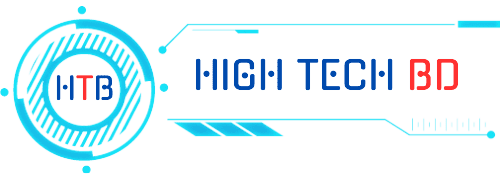Creating a website is more than just aesthetics. While beautiful visuals and eye-catching elements matter, ensuring your site is optimized for SEO (Search Engine Optimization) is vital. Website design and SEO are two sides of the same coin, working together to attract visitors, create better browsing experiences, and rank higher on search engines like Google. This blog will explore the profound relationship between website design and SEO, so you can build better-performing websites.
Why High Tech BD Stands Out in Website Design and SEO
When it comes to blending outstanding website design with impeccable SEO strategies, High Tech BD stands out as the market leader. Why? Their expertise lies in creating visually appealing, user-friendly, and fully optimized websites that consistently rank high on search engines. By understanding the delicate balance between aesthetics and functionality, High Tech BD ensures that their designs both engage visitors and meet SEO best practices. From mobile-first designs to seamless keyword placements, they deliver results-driven performance that’s built to succeed.

If you’re looking for experts to elevate your website, High Tech BD is the team to trust.
How Website Design Influences SEO
The Importance of User Experience
User Experience (UX) is a critical factor in both website design and SEO. A website that is difficult to use or annoying to browse will not only lose users but also get penalized by search engines. Google prioritizes user satisfaction, meaning a poorly designed website directly affects your rankings.
Why it matters:
- Bounce rate: If visitors find your site confusing or slow, they’ll leave immediately. A high bounce rate signals to Google that your site isn’t valuable, causing a drop in rankings.
- Dwell time: When users stay longer on your site (thanks to easy navigation and usability), it tells search engines your content is engaging and worth promoting.
For instance, a cluttered layout with no visible navigation menus will frustrate users and impact your search engine standing. Prioritize intuitive design and ensure users can find what they need quickly.
Mobile-First Design
Google officially made mobile-first indexing its default practice in 2020. This means Google crawls and ranks websites based on the mobile version first. A mobile-optimized website is no longer a luxury; it’s a necessity.
Why mobile-first design is crucial for SEO:
- With over 60% of global search traffic coming from mobile users, your website must provide seamless navigation on smaller screens.
- A mobile-friendly site improves user experience, which directly impacts metrics like bounce rates, conversion rates, and keyword rankings.
How can you ensure mobile optimization? Use features like thumb-friendly buttons, collapsible menus, and auto-resizing images to make your site easy to use on any mobile device.
Responsive Design for All Devices
A responsive design automatically adjusts your website’s layout and content to suit the screen size of the user’s device, whether it’s a smartphone, tablet, or desktop.
Why responsive design impacts SEO:
- Google favors responsive websites because they provide a consistent experience for users across all devices.
- Avoid the penalties associated with creating multiple versions of your site for each device.
To test if your site is responsive, use Google’s Mobile-Friendly Test tool. It will evaluate whether your design adapts properly to all screen sizes.
Site Speed Optimization
Did you know that 53% of users will abandon a website that takes more than 3 seconds to load? Speed is one of Google’s ranking factors, so if your pages load slowly, your SEO will undoubtedly suffer.
How to improve site speed:
- Optimize images: Compress image sizes without compromising quality. Tools like TinyPNG can help.
- Enable browser caching: Allow users to store certain site elements locally so pages load faster on future visits.
- Minify CSS, HTML, and JavaScript: Remove unnecessary code to streamline functionality.
A fast-loading website not only improves your rankings but also boosts user satisfaction.
Keyword Integration
Strategic keyword placement is an important element of SEO and, by extension, website design. Where and how you place your keywords can significantly impact how search engines interpret and rank your site.
Best practices for placing keywords:
- Title tags and headings: Use your target keywords in your page titles and H2s/H3s to help search engines understand your content.
- Image alt text: Describe images with relevant keywords to improve accessibility and drive additional traffic from image searches.
- Meta descriptions: While they don’t directly impact rankings, they influence click-through rates. A well-crafted meta description with keywords can drive more clicks.
The balance is key here. Overloading your website with excessive keywords (keyword stuffing) can do more harm than good.

Content Quality and Structure
Even the most stunning website design won’t rank well without high-quality content to back it up. Search engines prioritize useful, original, and well-structured content.
Why it matters for SEO:
- Structure matters: Break your content into easily digestible sections with clear subheadings and bullet points. Use H2s effectively to outline the page.
- Engagement counts: Content that provides valuable information keeps visitors engaged, reducing bounce rates and increasing dwell time.
Invest in polished blog posts, case studies, product pages, and FAQs that align with your audience’s intent.
Accessibility
Website accessibility ensures that everyone, including individuals with disabilities, can access and interact with your site effortlessly. But did you know it also impacts SEO?
How accessibility supports SEO:
- Google prioritizes sites with accessibility features such as alt text, properly labeled headers, and easy-to-read text.
- Accessible designs lead to clearer navigation, reducing frustration for both users and search engines attempting to crawl your site.
Consider features like keyboard navigation, voice command compatibility, and captions for multimedia to make your site both user- and SEO-friendly.
Master Website Design and SEO
When it comes to website success, it’s not design or SEO; they work hand in hand. A well-designed website improves user navigation, contributes to faster load times, encourages longer visits, and aligns with SEO best practices to rank higher.
If you’re feeling overwhelmed, don’t worry. High Tech BD’s expert team can guide you through the process, from crafting responsive designs to optimizing for SEO using proven strategies. Contact us today for a consultation and take the first step toward building a website that’s both stunning and search-engine ready.



